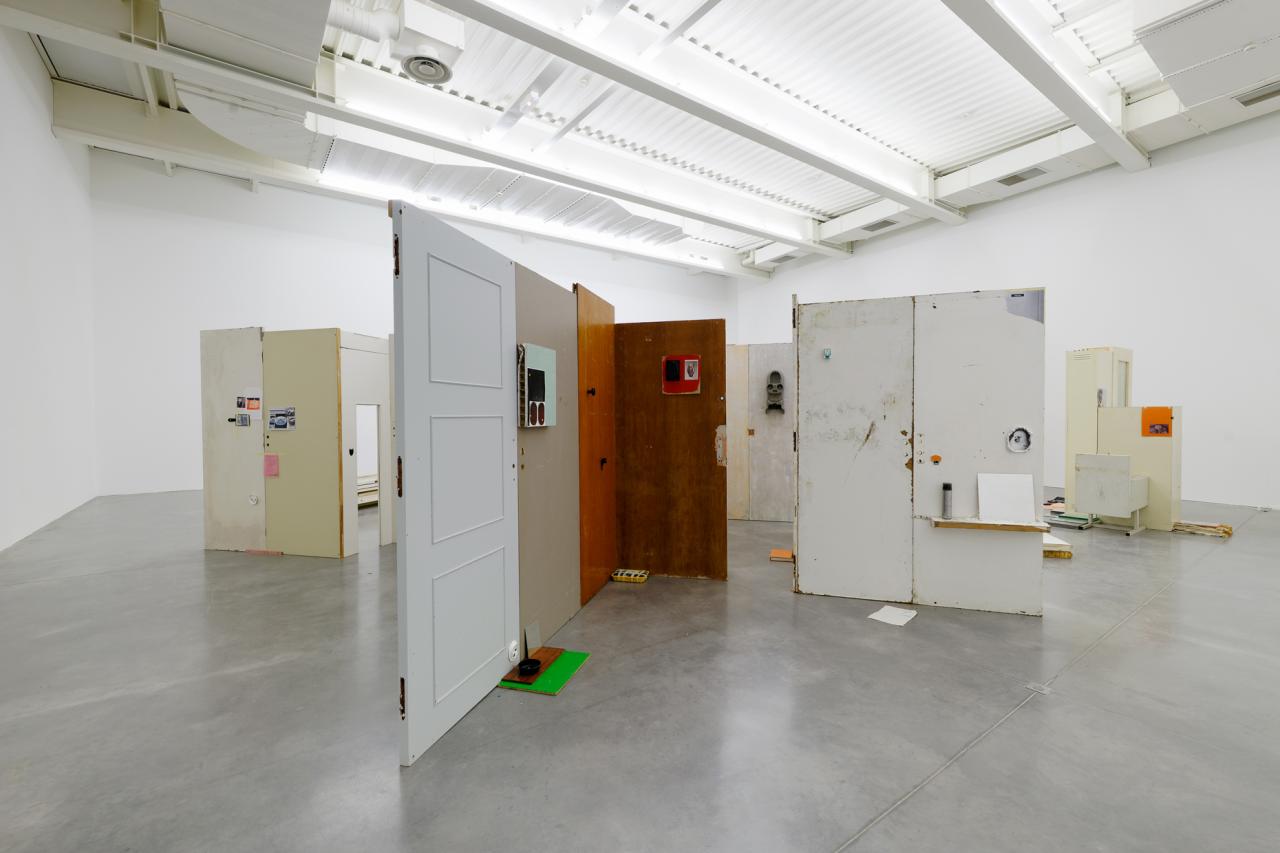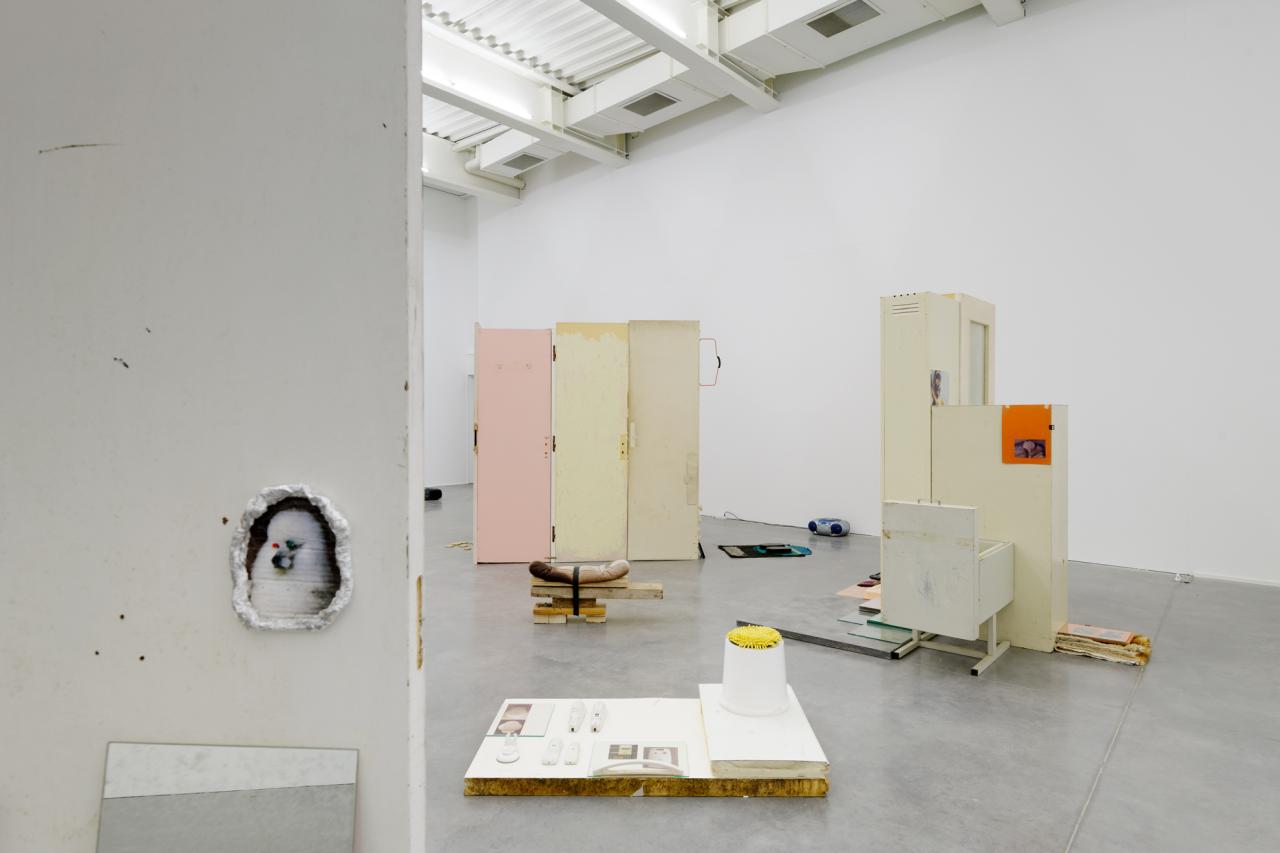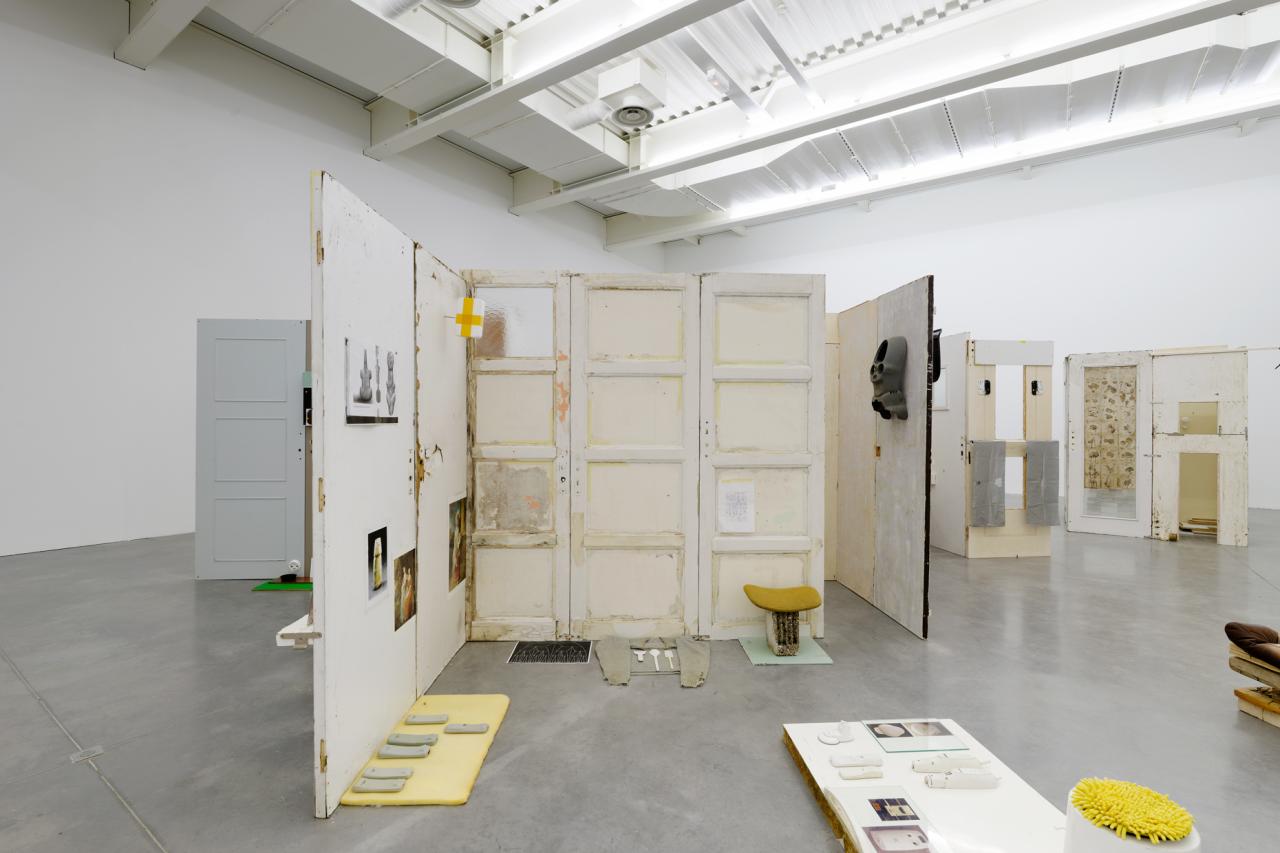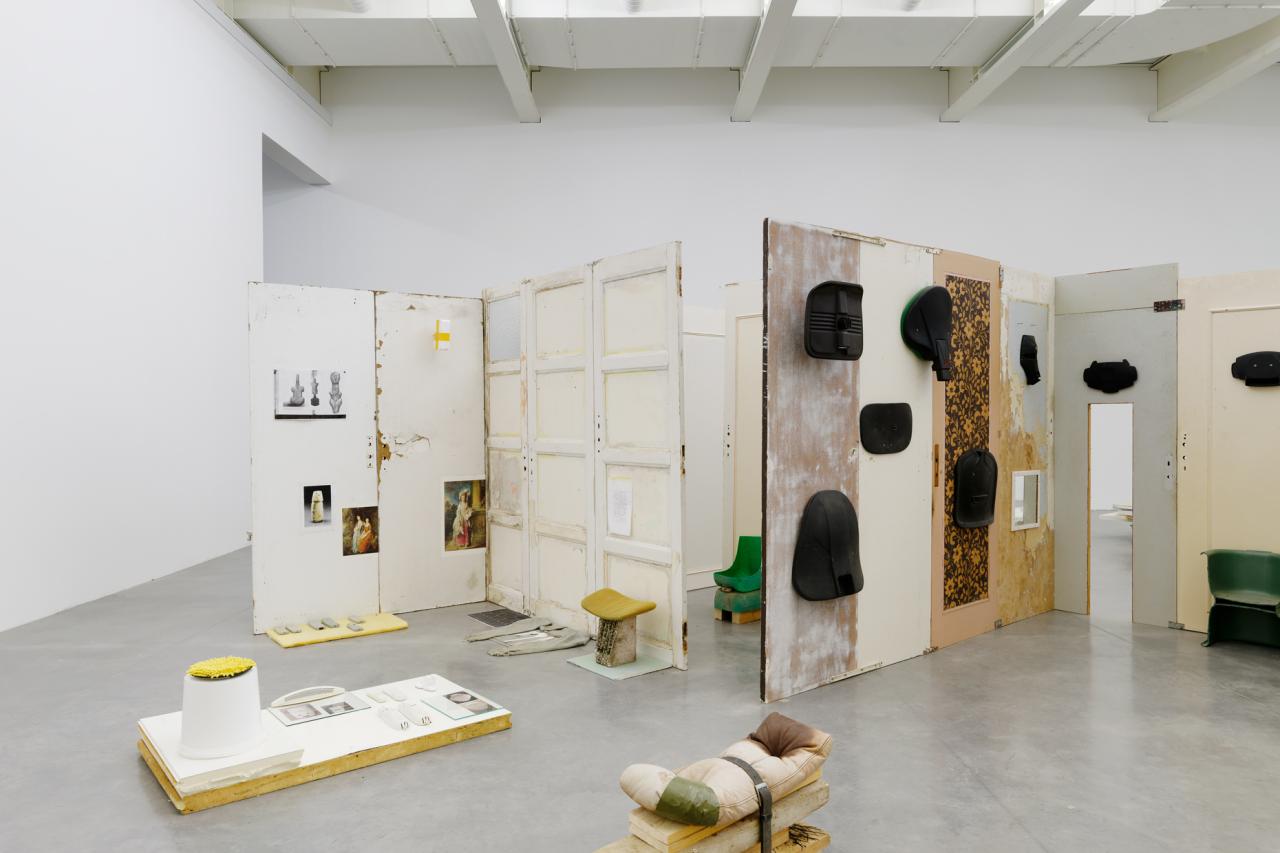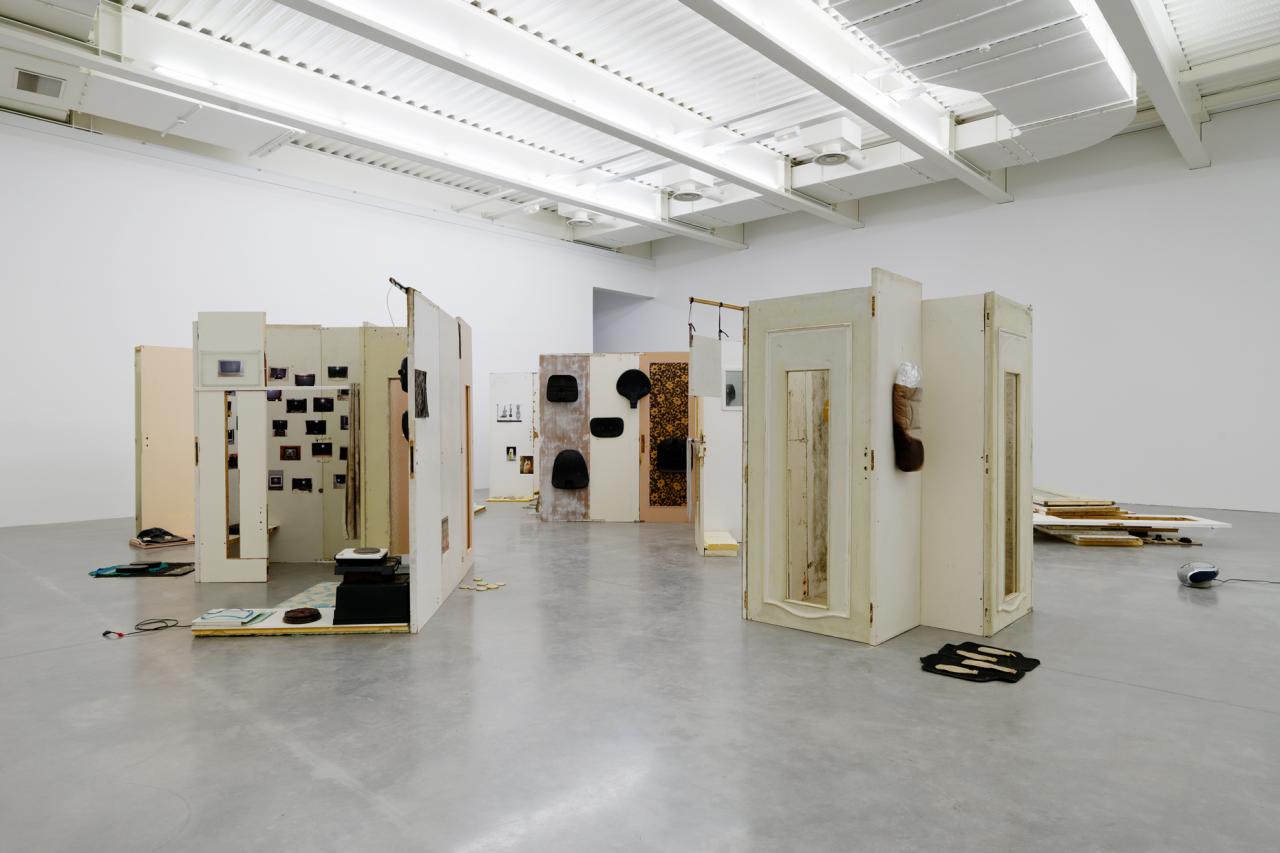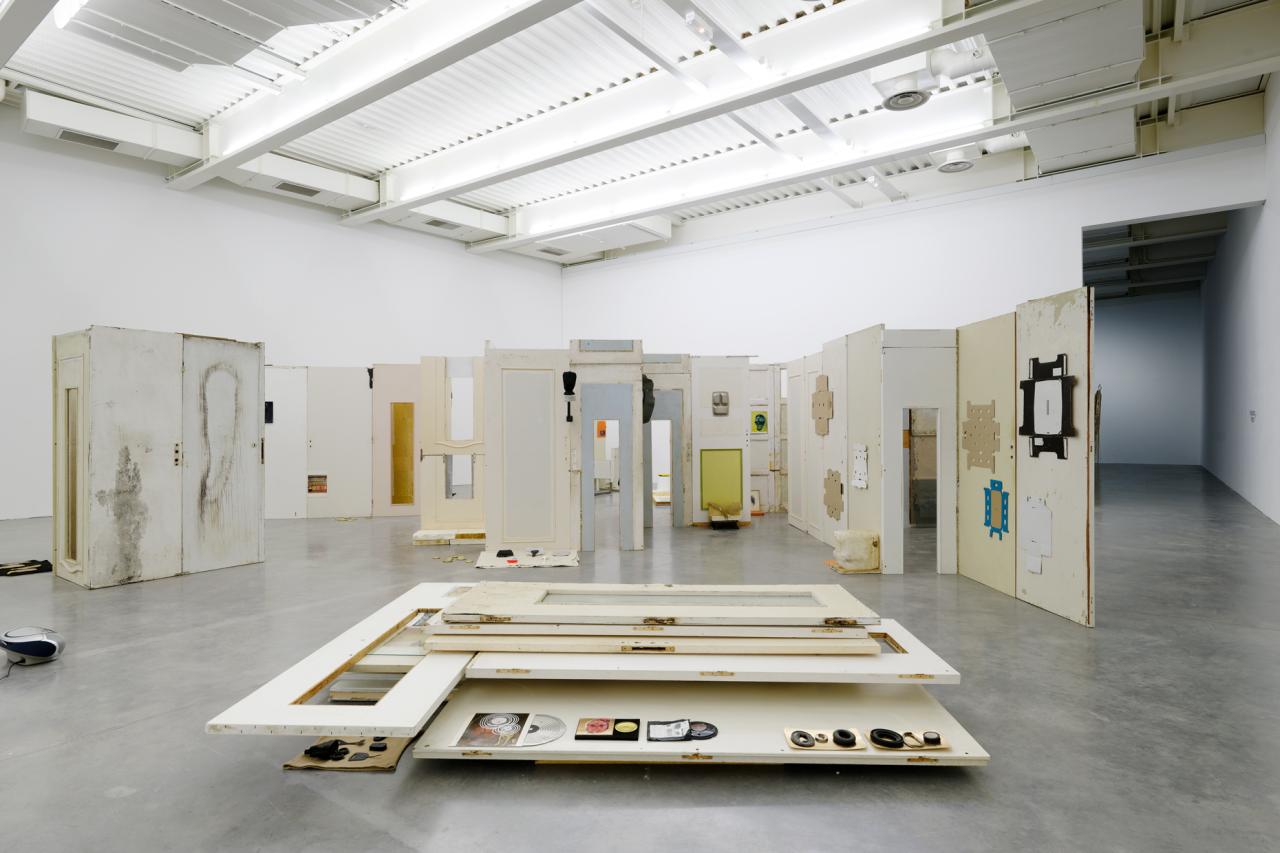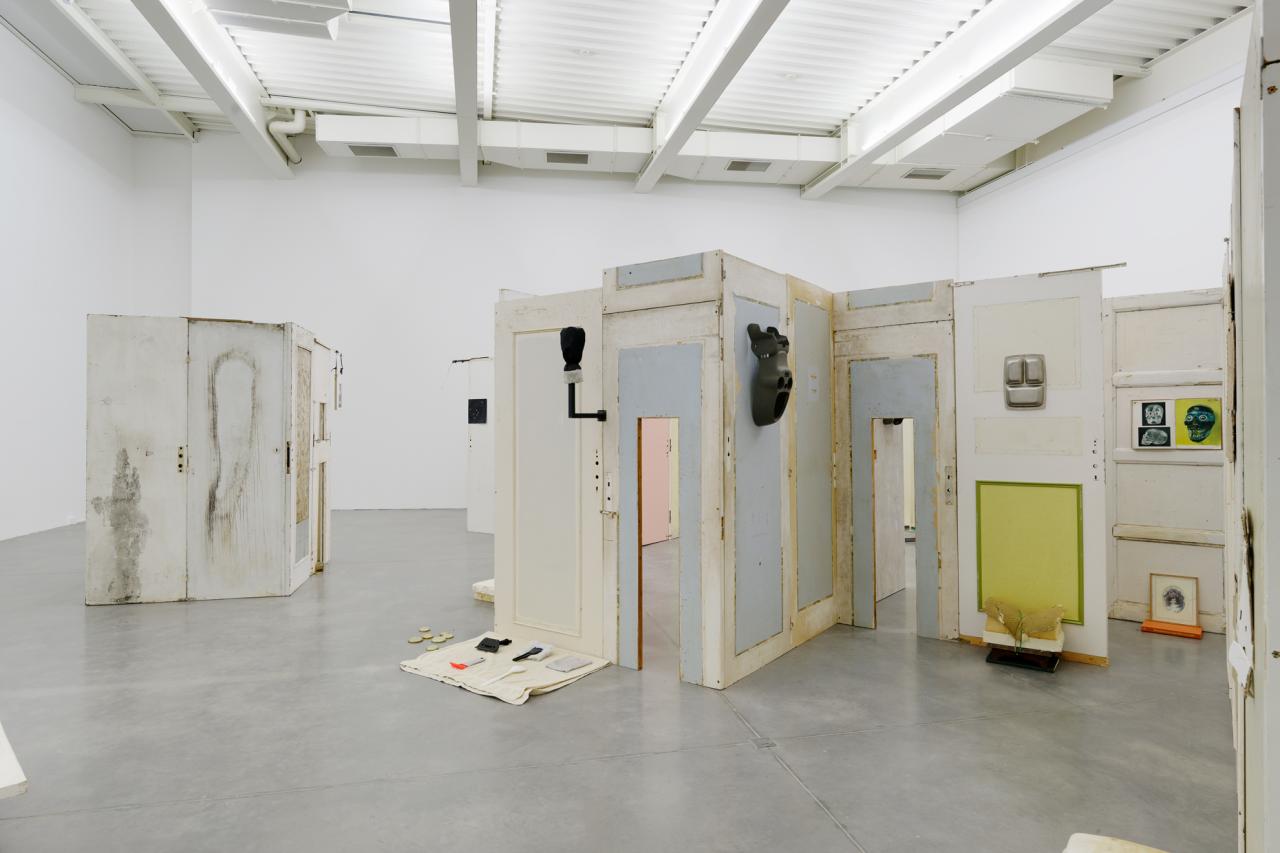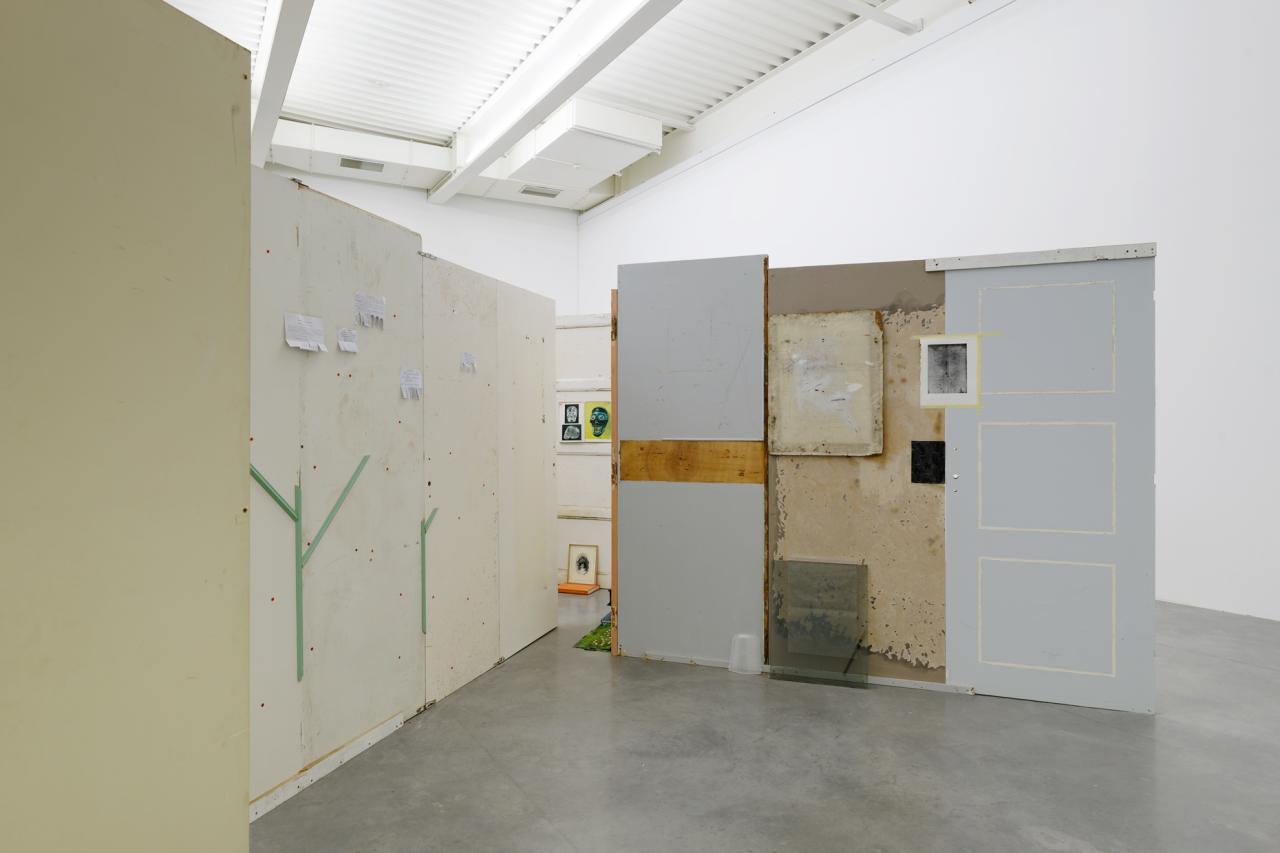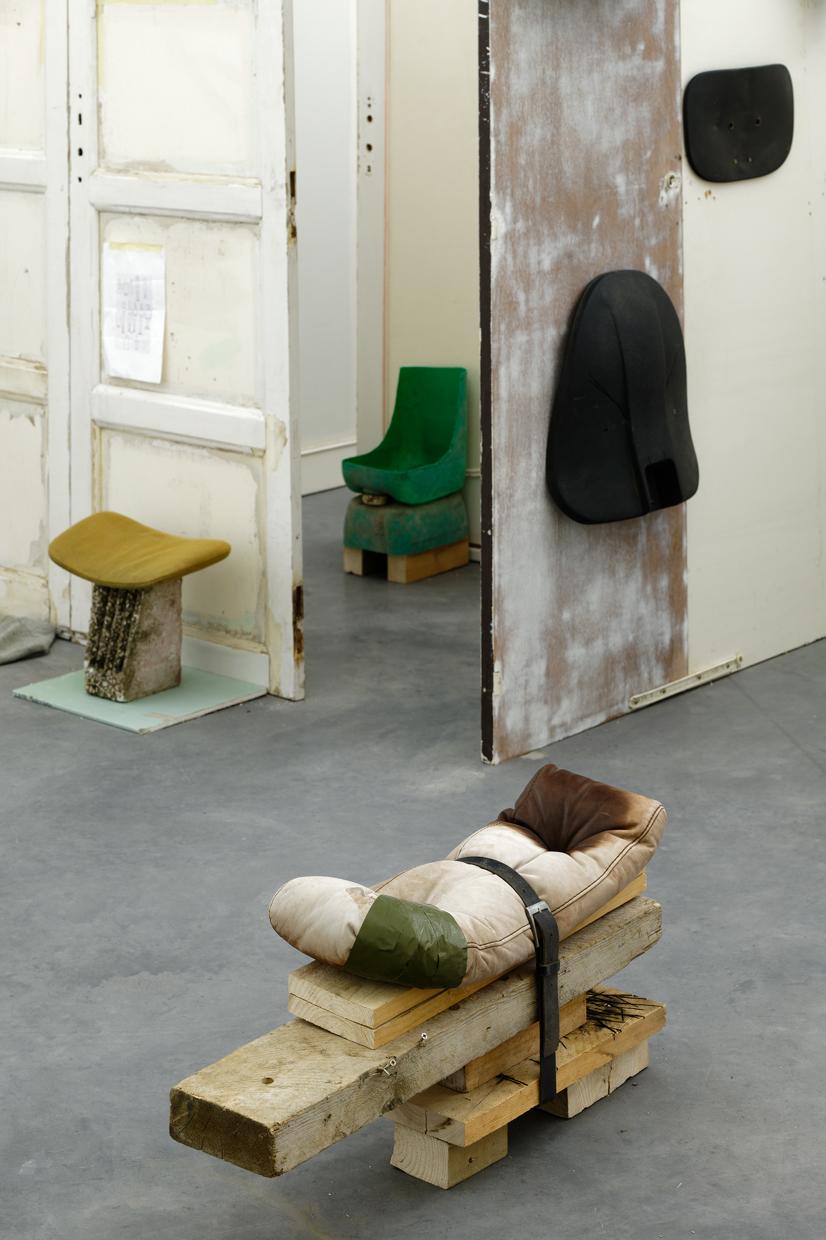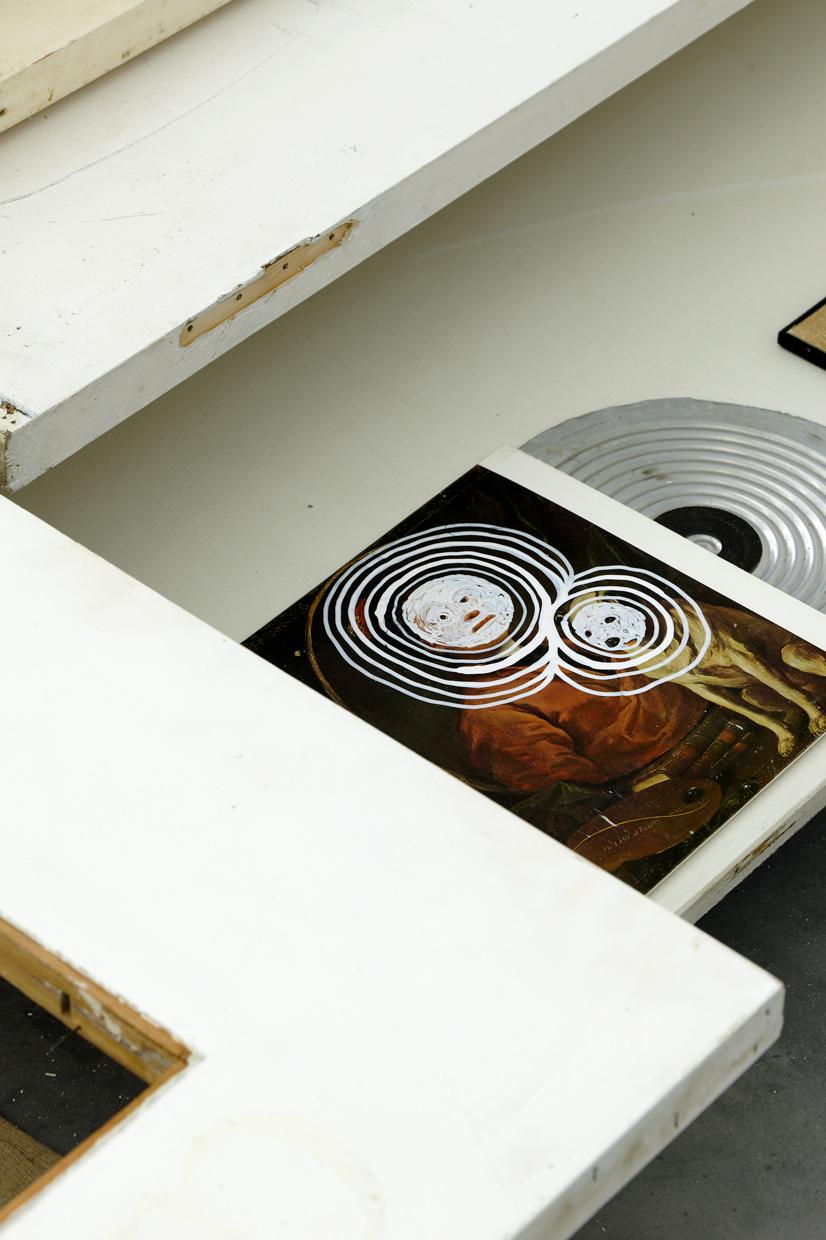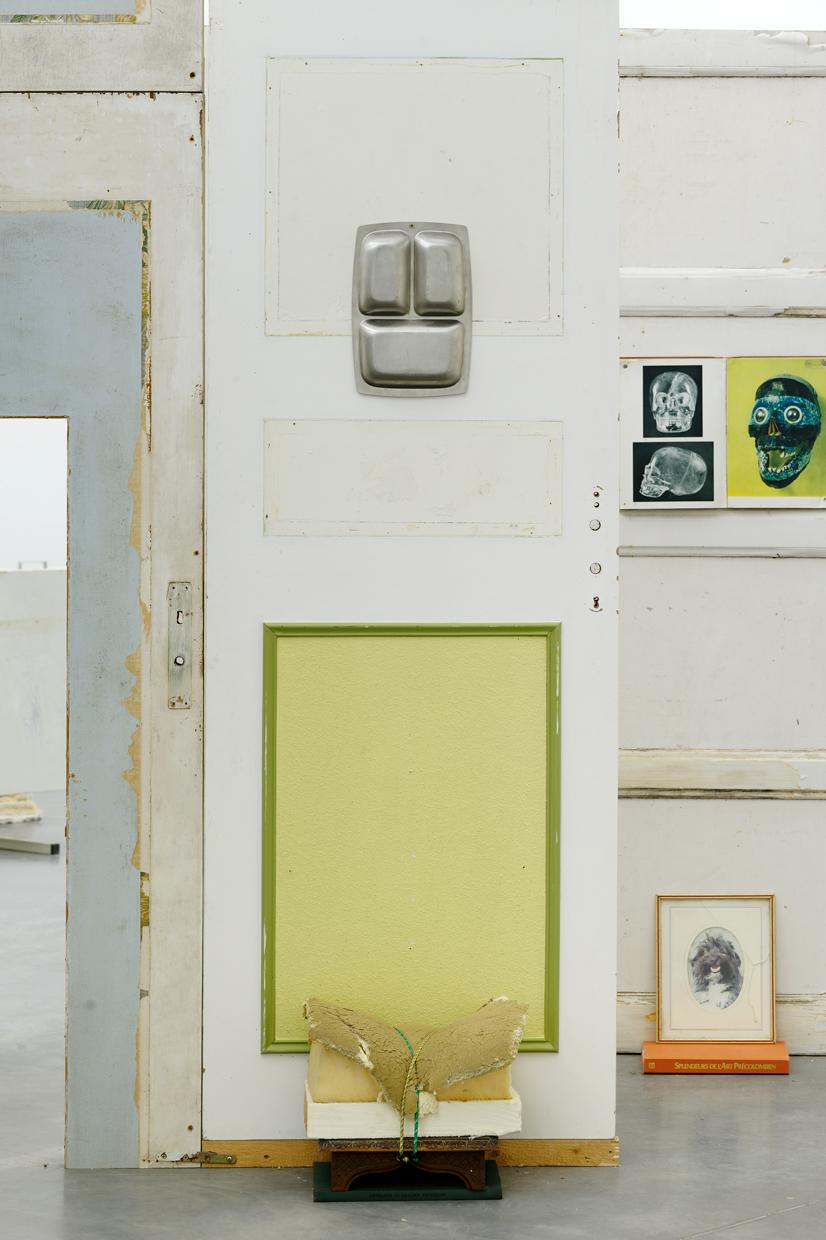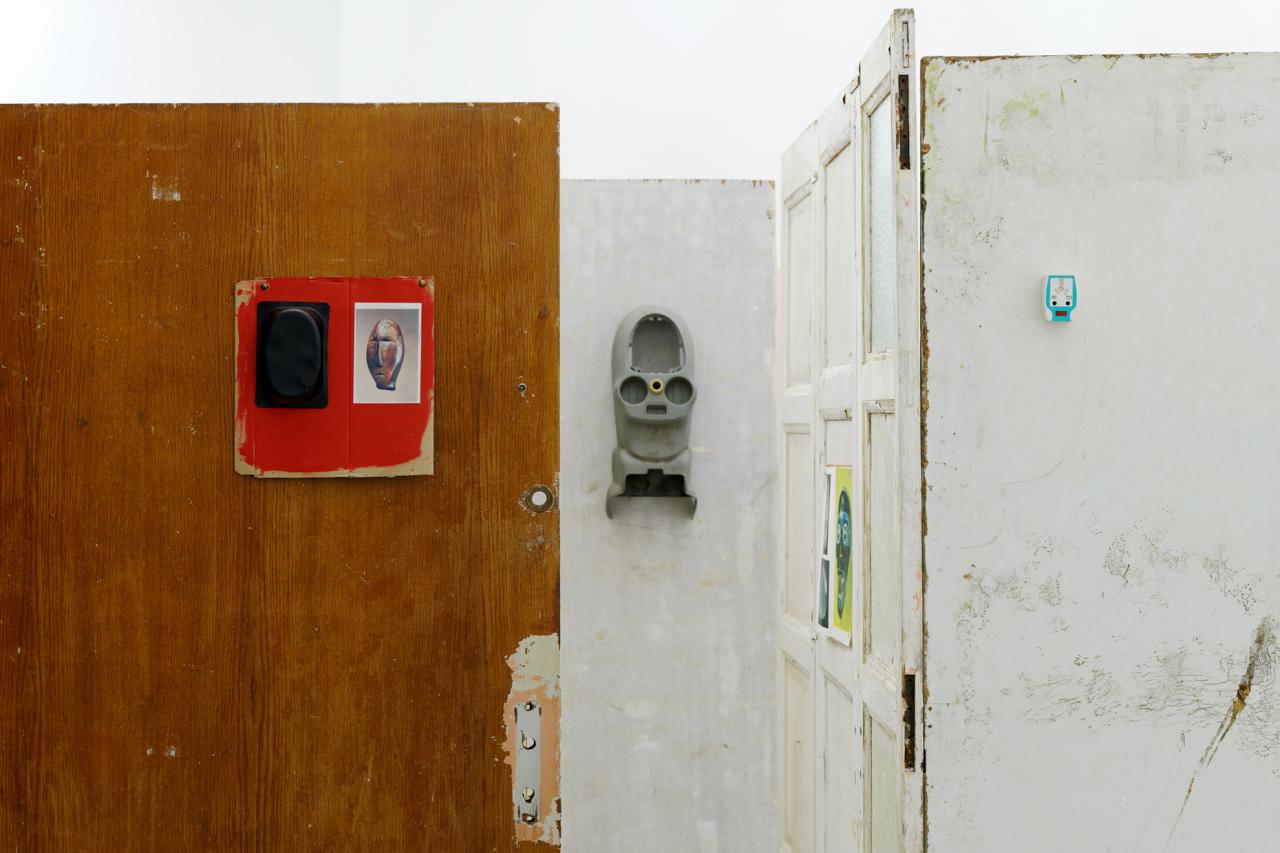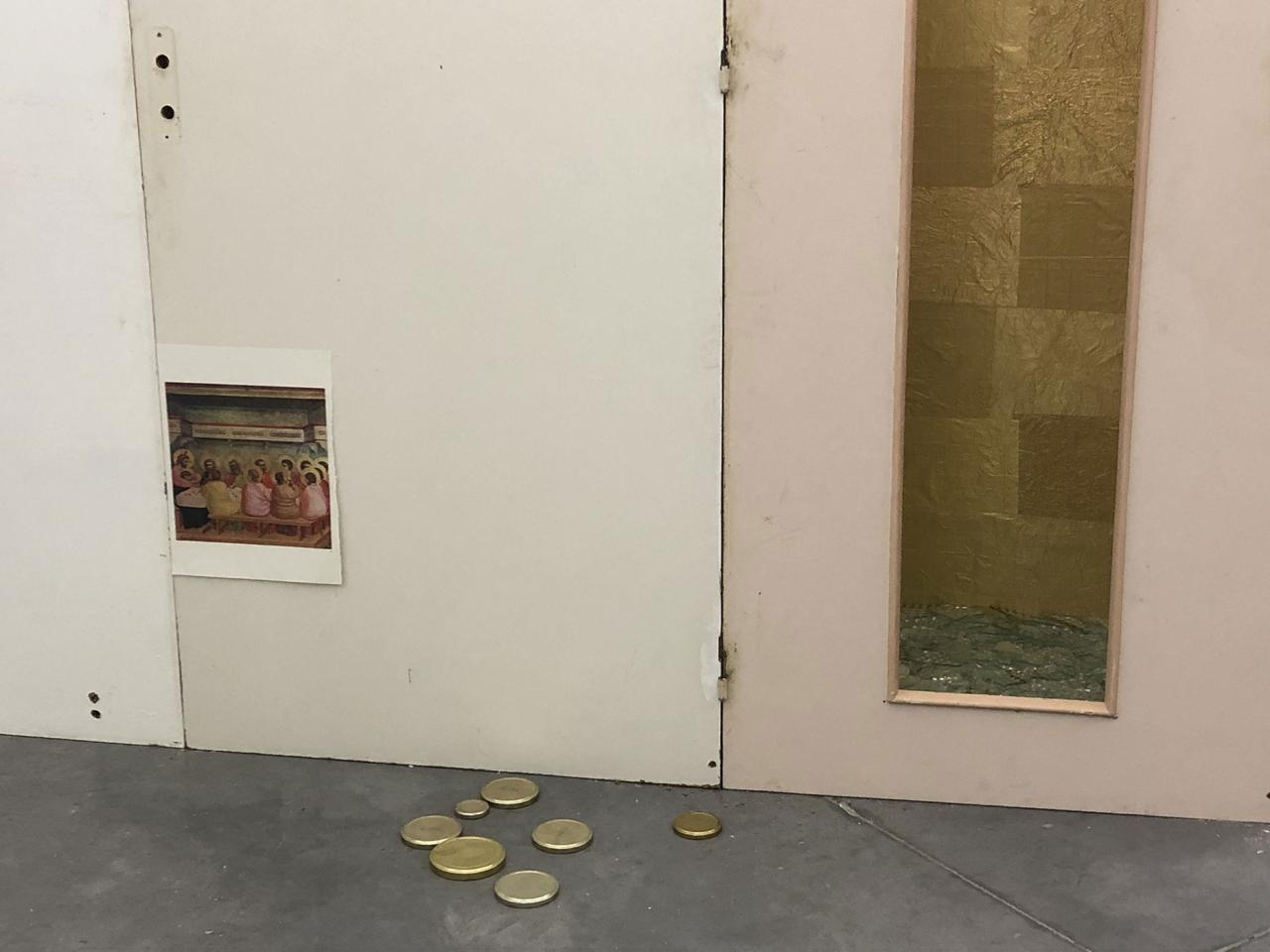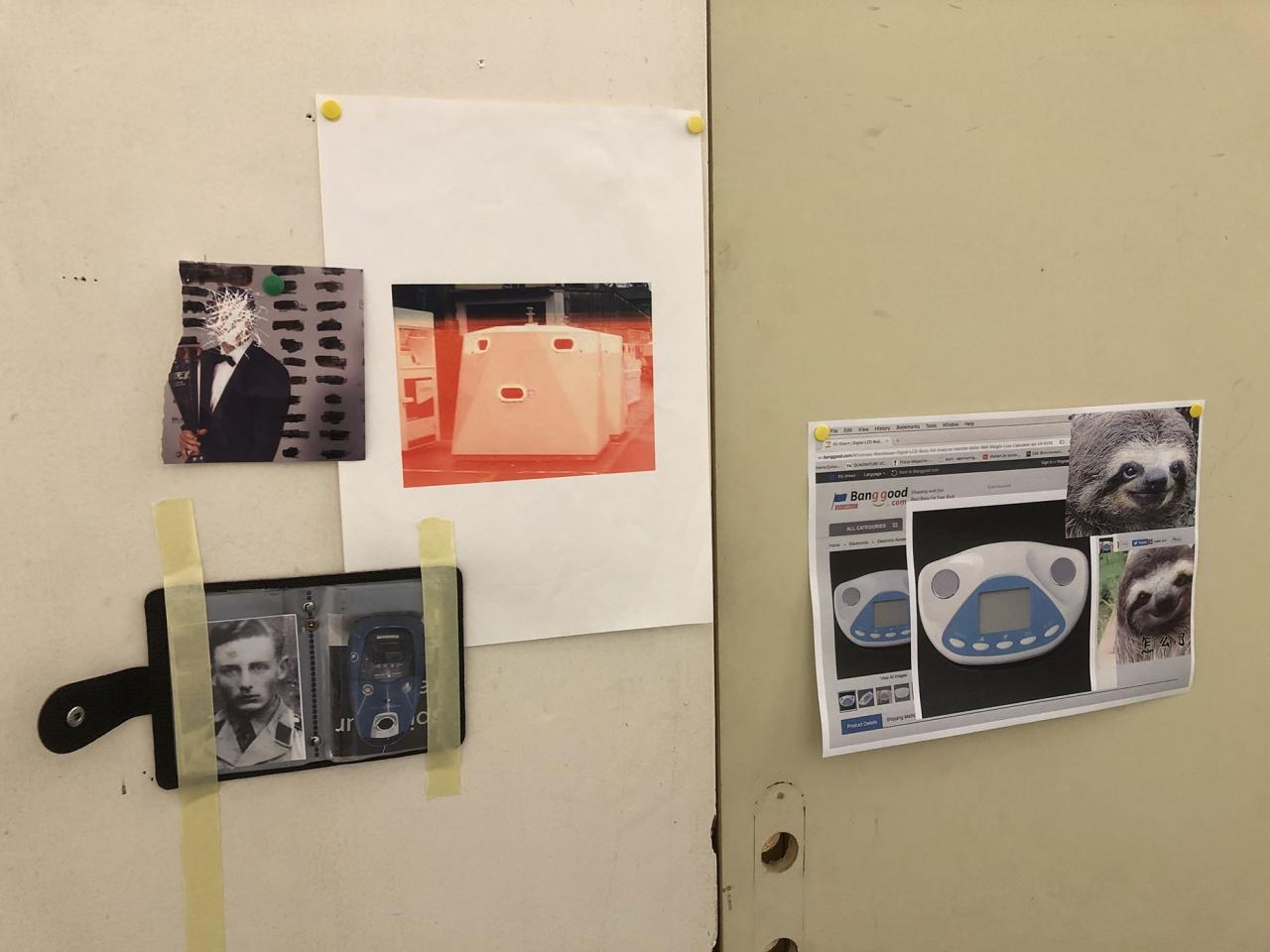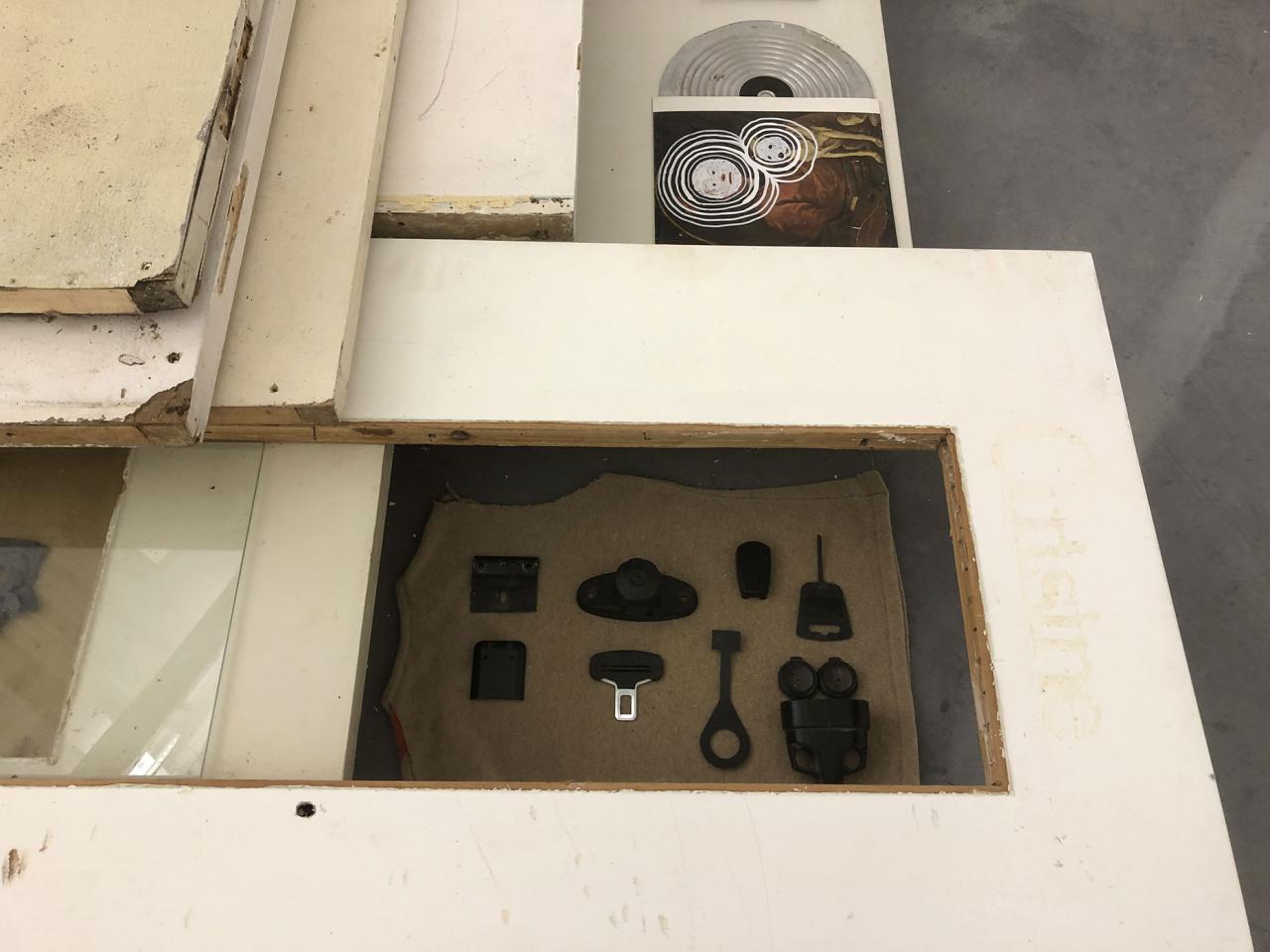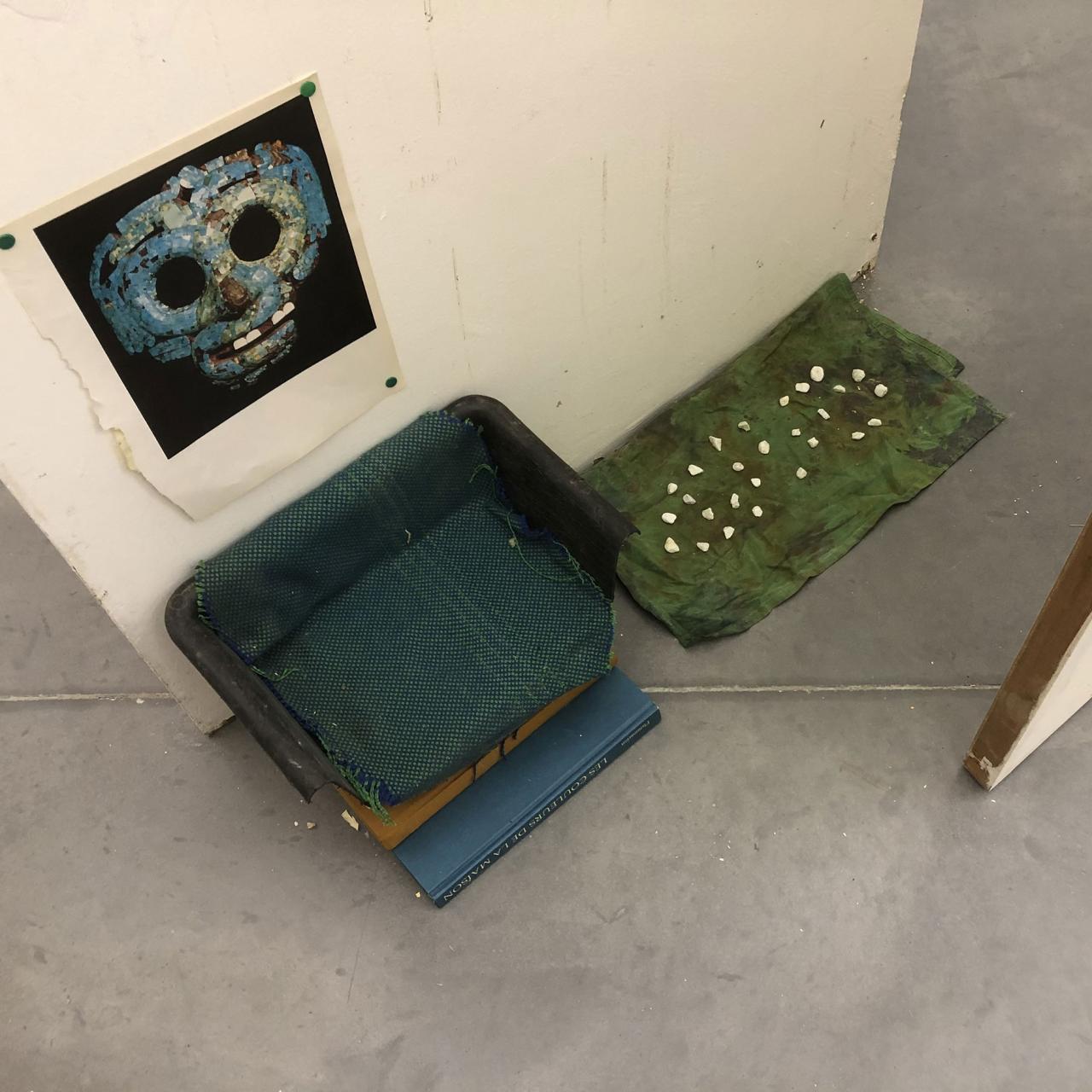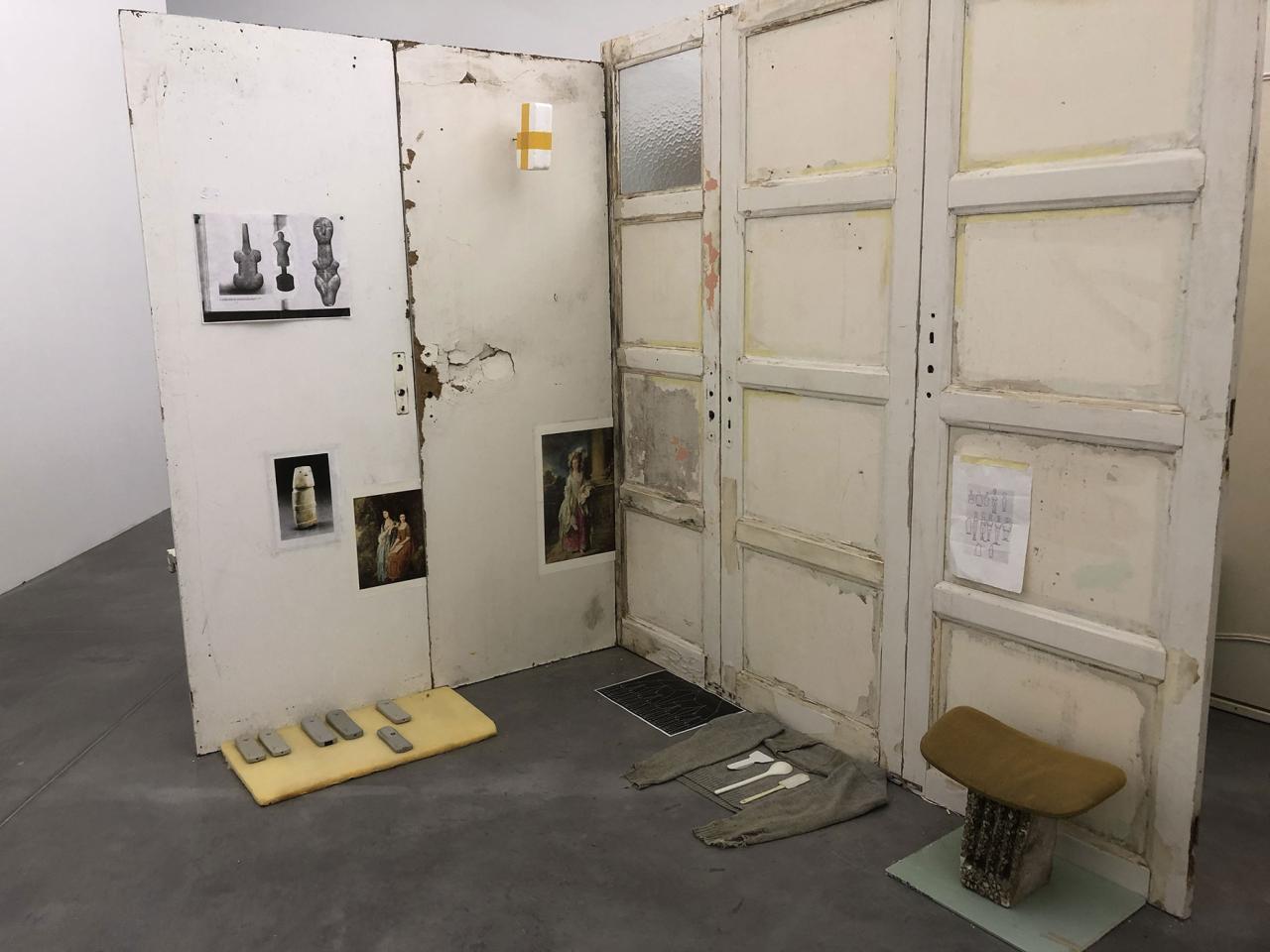Francesco Finizio
The trash collectors of the future had looked at the Constructivists :
Francesco Finizio’s promise
Folded in half on the floor, a scratchy cream bath towel serves as a plinth for a series of ice scrapers. Carefully arranged, the varied shapes evoke a new kind of hieroglyphs. Immediately beside this strange convergence of uses—bodily hygiene and automotive visibility—a modest collection of flat screwcaps are strewn on the ground like forgotten coins, with their deliciously antiquated gilded halo. Compelling in its nonchalance, this detail of the assemblage appears amidst a succession of doors, windows, and partitions that create alcoves, corridors, thresholds, and such. The makeshift architectural forms give a certain rhythm to our transit through this space, a hybrid between the ruins of a soviet building and an ikea display: the Swedish brand’s central concept is to give the illusion of multiple choices for the interior of the same house. Francesco Finizio calls these multiple entry signals that punctuate his labyrinthine installation Go Ghost ! (2021) at Frac Bretagne “punch lines,” witticisms or Freudian slips dictated not by the interplay of language but by the objects themselves.
These things, all of different rank, are haunted by the promise of a “primitive” scene from the Cohen Brothers’ film, No Country for Old Men (2007), that Francesco Finizio invokes. It is the scene where Javier Bardem transforms a simple coin toss into a frightening wager on a man’s life. The psychopath tells the cashier—who has just been spared—to regard the coin that has just saved him as something rare, and to not mix it in with the others; otherwise it would look like any of them. The founder of Marxism would read in this an allegory of capitalist fetishism; I see a new way of (re-)defining assemblage, still too entrenched in “East Coast” modernism.
Nothing predestined Francesco Finizio, a former student of Joseph Kosuth, to the American materialist interpretation of European Dadaism. If Go Ghost ! holds any remnants of semiotics, it is in its collections of trash. On reading Anne Giffon-Selle’s Les astronautes du dedans, L’assemblage californien 1950-19701, I realized how much the familiar “West Coast” feeling in the huge anarchic ordering of the 2021 installation is aided by visualizing the major pieces of Wallace Berman, Bruce Conner, Jess, Edward Kienholz, George Herms, and Wally Hedrick. The “astronauts of inner space” thwart the modernist vision of William C. Seitz, father of The Art of Assemblage, held at MoMA in 1961, all while impertinently illuminating Go Ghost ! and fixing it in a succession of gestures and of empowerment. In this instance, Californian artist Bruce Conner has, according to Anne Giffon-Selle, “detected an enterprise of shaping and formalizing a new genre equipped with every artistic filiation, essentially modernist and pictorial.”2 The vision shared by Wallace Berman, Bruce Conner, Jess, Edward Kienholz, George Herms, Wally Hedrick—and more recently, Francesco Finizio—has more to do with a stubborn refusal of any “historicist interpretation” or “formal determinism” while simultaneously flirting with a “wasteland” aesthetic3. The latter contributes to nourishing a fertile soil to prevent the sedimentation, the fossilization of the city’s historical-cultural events. Let’s not forget that for the Angelinos and the Franciscans, Europe, as well as the cities of the East Coast, are considered the “Old World”. Immutable in this belief, they navigate a vision of contemporaneity constituted simultaneously in amnesia—conducive to neoliberal activities—and an adolescent enthusiasm where everything is possible. It is enough to rewatch the innumerable Hollywood westerns, or the films of the Cohen brothers, to understand with exactly what performative power this timeless myth is part of a North American culture that distinguishes itself from the patrimonial construction of old continental Europe.
Californians’ attraction to poets and Dadaist artists can be read, according to Anne Giffon-Selle, as being at the start a violent “individualist resistance” to “all artistic assimilation” 4, ideological and spiritual. The desire to seize abandoned objects or things has less to tell us about the consumption society—a theme worn thin in relation to assemblage and Pop Art—than to reveal individual ways of making memory. On this subject, Edward Kienholtz said:
“I really begin to understand any society by going through its junk stores and flea markets. It is a form of education and historical orientation for me.”5 That this enthusiasm for assemblage and collage emerged in California during the turbulent geopolitical context of the 1950s, is no coincidence. Francesco Finizio mentions having needed a certain time to shake off the East Coast conceptual heritage and to connect with the countercultures and counter-knowledge of the “wild boys” (William Burroughs) of the West Coast.
While looking at images of Pléstéchone (pronounced “playstation”) from his 2003 exhibition Transmission Studies at the Musée d’Art Contemporain in Marseille, Francesco Finizio confided in me that he wanted, in retrospect, to remove the imposing elements, the chairs, the desks, the partitions, the board, and such. He would have liked to have kept only the lists, the accumulations of very small plastic modules arranged on a shelf, to have encouraged others to manipulate, organize, and combine them according to the rules of board games (checkers or chess) or early arcade games. The charms of the possibilities of play—the way of advancing, tactics for staying one move ahead, the processes of turnarounds—are already shared by the assemblagists Wallace Berman (billiards and cards) and Marcel Duchamp: remember that celebrated game with Eve Babitz at the Pasadena Art Museum in Los Angeles. In his studio in Brest, we see, Francesco Finizio and myself, a precocious taste for assemblage. It continued in the Centre de Tri Visuel (2001), an installation that offered a space for the recycling and reconversion of glossy publications, where Francesco Finizio took the time to name and detail the group of plastic storage crates, stacked like Lego modules to form, in turn, counters, seats, and full-length plinths—on which the television broadcast self-promotional films—or even, storage boxes that allowed the erection of labyrinthine partitions that continually redesigned the installation’s space. Like a prefiguration of Go Ghost !, you moved around, you penetrated each space differently, and they, were raised and fell with indifference. An infinite playground where the plinth’s authority was never able to take hold.
These display shelves, counters, and seating are the common threads that we again find in his installation XIO-P(p)ing Thing (2019). In the back of a store in a Marseillais passage6, Francesco Finizio copied and pasted the basic functions of an airport (the transit and control of passengers) and its link with our time, to lose in consuming, in eating, or in watching others evolve in their own suspended time of waiting. The idea of the row and the invitation to sit is found in Vision Center (2012). An alignment of disparate chairs, their only character being a disquieting sense of banality, stages a tension between the dematerialized screens, reincarnated by the cushions, doormats, trays, and the potential spectators. The game of checkers or chess has been abandoned but the tactical spirit of substitution, evocation, and metamorphosis remain. A kind of corporate mesmerization in the image of the white column covered with office phones at the Museums of Bat Yam in Tel Aviv, in 2015.
In order to better suspend, defer, or neutralize them, the attributes of commerce’s heaving mass are made visible, sometimes with their potential multiplied, as in How I went In & Out of Business for Seven Days and Seven Nights (2008), for example. In the new Galerie ACDC in Bordeaux, Francesco Finizio opened and closed as many businesses as possible, using only found materials. While the texts and conversations of the “astronauts of inner space” demonstrate an interest in vitrines and “window dressing”, which the Surrealists praised for their “process moved by an internal necessity... Where things are linked one to another following their own logic”7, Finizio associates them with a fascination for the viral potential of objects. This anxiety-inducing viral nature can even result in a “climate of paranoia”, according to his own words. In Minimalia (mini-mal-ya) things that are meant to be reassuring—colorful garden houses, the heads of stuffed toys, children’s clothes—instead embody haphazard habitats or security checkpoints, like those Francesco Finizio saw in Tel Aviv. His 2013 performance Never Trust a Stranger—featuring a rabbit escaped from Walt Disney handing out flyers decrying conspiracy theories while recirculating them—extended the artist’s solo show beyond the Tel Aviv museum’s wall, heightening a feeling of weight peculiar to the “society of control” (Gilles Deleuze). This exhibition worked like a collage of objects worthy of Mike Kelley’s “uncanny”: “The uncanny is a somewhat muted sense of horror: horror tinged with confusion.”8 Mike Kelley had (already) integrated a critique of neoliberal white suprematism, because he extended the dissident ambition of the West Coast assemblagists. Aware of the performative force and visual power of the ultra-capitalist North American ideology, in Ramoneur – Dentiste – Visionnaire, Francesco Finizio’s “uncanny” multiplies votive scenes and micro-situations of recollection without remembering the raison d’être of these liturgical prayers. The “fetishist’s ‘harem’”9 mimics the idols inhabited by childish beliefs, a libidinal machine that stirs Francesco Finizio, this “trash collector of the future who’d apparently looked at the Constructivists.”10
1 Anne Giffon-Selle, Les astronautes du dedans : l’assemblage californien 1950-1970 (Dijon : Les Presses du réel, 2017).
2 Ibid., p. 25.
3 Ibid., p. 86.
4 Ibid.
5 Ibid., p. 99. Originally quoted in quoted in Roland W. Wiegenstein, “Ed Kienholz, the ‘Volksempfängers’ and the ‘Ring,’” in Edward Kienholz: Volksempfängers (exh. cat. Berlin: Nationalgalerie, Berlin, 1977).
6 Galerie Territoires Partagés, Marseille.
7 Anne Giffon-Selle, Les astronautes du dedans, p. 91.
8 Mike Kelley, The Uncanny (Cologne : Walther Köning, 2004), p. 26.
9 Ibid., p. 38.
10 An expression of the artist.
